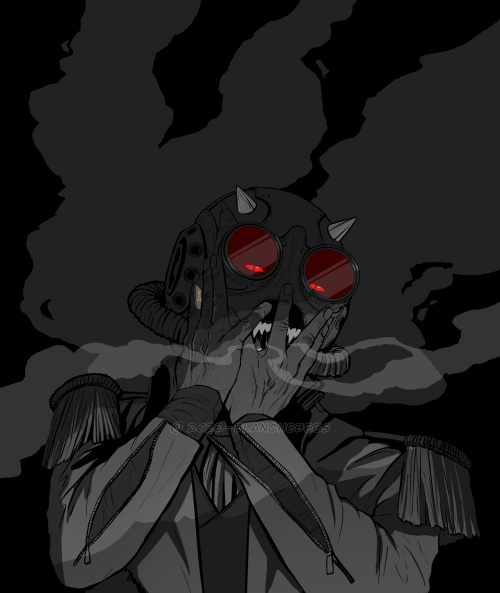Ghouls!!!! - Blog Posts
HELP WHY AM I HEARING OMINOUS MUSIC

It’s on goingggg and I love them🩷🩷🩷
Taking a deep breath and counting backwards from ten

no yeah it’s totally casual
we fuck at midnite- yk when her ghost can finally escape the realm of purgatory- and then she leaves before the sun rises to serve out the rest of her uncertain afterlife
(´༎ຶོρ༎ຶོ`)


SURPRISEE!! Ghoul Johnny exists in the Fallout 2077 AU!!
The real Johnny didn't end up dying, instead he became a Ghoul from the intense radiation from the Nuke
Vault boy Johnny existing and gaining sentience is quite the mystery
Ghouls are, put simply, humans suffering from advanced, prolonged radiation sickness and whose bodies have mutated such that gamma radiation extends their lifespan past natural limits.
The process of ghoulification is outlined in canon sources, but I wanted to make a guide that goes into more detail on the effects of radiation sickness in various cases, since the level and type of exposure significantly affects the outcome.
This is the first in what will be a series of posts exploring both real-life cases of radiation sickness and the sci-fi concept of ghoulification in some depth. Graphic descriptions of the physical deterioration of the body are included for informative purposes; reader discretion is advised.
For this first case study, I examine the effects on the human body of exposure to high levels of radiation in a short period of time, with a focus on the real case of Hisashi Ouchi.
On September 30, 1999, a lack of appropriate safety measures and the proper materials resulted in an accident that caused three workers at the nuclear power plant in Tōkai-mura, Japan, to suffer from severe radiation poisoning while purifying reactor fuel.
Point of Criticality
An uncontrolled fission reaction was produced when technicians poured nearly seven times the legal limit of uranium oxide into an improper vessel containing nitric acid. The men reported seeing a bright blue flash—indicative of Cherenkov radiation—when the mixture reached critical mass, flooding the room with radiation. The workers evacuated to the decontamination room, but already, the two who had been handling the reactive solution were overcome with intense pain from radiation burns, severe nausea, and difficulty breathing. Hisashi Ouchi, who suffered the highest level of exposure, also experienced rapid difficulties with mobility and coherence. Upon reaching the decontamination room, he vomited and fell unconscious.
~1 Hour Post-Exposure
Ouchi regained consciousness in the hospital about 70 minutes after the criticality accident, where doctors confirmed that he had been exposed to high doses of gamma, neutron, and other radiation.
The maximum allowable annual dose of radiation for nuclear technicians in Japan was 50 millisieverts. Exposure to more than 7 sieverts is considered fatal. Yutaka Yokokawa, the supervisor, had received 3 sieverts. The technicians who had been handling the uranium, Masato Shinohara and Hisashi Ouchi, received 10 sieverts and 17 sieverts, respectively.
~1 Day+ Post-Exposure
During the first few days in the ICU, Ouchi appeared to be in remarkably good condition, given the circumstances: the skin of his face and right hand was slightly red, as if by a sunburn, and swollen. His eyes were bloodshot, and he reported pain under his ear and right hand, which had received the most direct exposure, but he could speak normally, and he joked with the doctors and nurses attending to him.
6 Days Post-Exposure
Tests revealed that the high energy radiation that Ouchi had been exposed to had obliterated the chromosomes in his bone marrow. They were unrecognizable—some severed, some fused, all out of order. This damage meant that his body was unable to create new blood cells. The red blood cells that transport oxygen could not be replaced, and Ouchi's white blood cell count was near zero, leaving him extremely vulnerable to infection.
~1 Week+ Post-Exposure
Intensive treatments, including numerous skin grafts, blood and bone marrow transfusions, and revolutionary stem cell transplants were conducted in an attempt to stabilize Ouchi, but ultimately without lasting success.
The skin grafts couldn't hold; when medical tape was peeled from his skin, his skin came with it, and the marks left behind couldn't heal. Blisters like those of a burn appeared on his right hand.
Ouchi reported frequently that he was thirsty.
~10 Days Post-Exposure
By this point, Ouchi's oxygen levels were so low that even speaking required tremendous effort. Ouchi was placed on supplemental oxygen and required sedatives to be able to sleep.
2 Weeks+ Post-Exposure
Ouchi was no longer able to eat and required an IV. By day sixteen, most of the skin on the front side of his body had fallen off.
His low platelet count and lack of healthy skin meant that his blood and bodily fluids leaked through his damaged pores, resulting in unstable blood pressure.
Donor stem cells that were meant to allow his body to create new tissue were also destroyed by the radiation present in his body.
~1 Month Post-Exposure
On the 27th day following the accident, Ouchi suffered from intense diarrhea. The mucus layer of his large intestine had vanished, exposing the red submucosal layer beneath. His body could no longer disgest or absorb anything he ingested; even water was excreted as diarrhea.
The skin of Ouchi's right hand was almost entirely gone, leaving the surface of his hand raw and dark red. Blisters spread across his right arm and abdomen, then over his entire body. Gauze was required to replace his skin, and his fingers had to be individually wrapped to prevent them from sticking together. Without skin to keep him warm, Ouchi required an electrothermic device to maintain his body temperature while his bandages were changed—a daily procedure that took hours. Every time the gauze was removed, more of Ouchi's remaining skin went with it. His eyelids could not shut, and his eyes bled. His nails fell off.
Ouchi's right arm was necrotizing, leading to an increasing amount of myoglobin—a protein in muscle tissue—flowing in Ouchi's blood. Untreated, this could result in renal failure as the kidneys could not process the amount of myoglobin present.
Ouchi's body could not regenerate the platelets that form scabs, meaning the risk of hemorrhage was extreme.
By day 50, more than two liters of fluid seeped from Ouchi's damaged skin each day. The amount of fluid prevented skin grafts from adhering. Furthermore, he began to suffer from blood in his stool, and permeated blood seeped between his inflamed small and large intestines.
2 Months+ Post-Exposure
On the 59th day after the accident, Ouchi suffered the first of many heart attacks. His kidneys and liver were also failing. He no longer showed reactions to stimuli.
By day 63, Ouchi's macrophages—the immune cells that normally attack and consume bacteria and viruses—were attacking his own healthy blood cells.
After 67 days, Ouchi suffered internal hemorrhage. He bled from his mouth and intestines.
Ouchi would continue to suffer from heart attacks, as many as three in one hour. Each time, he was revived, but he suffered increasing brain damage, until multiple organ failure ended his life after 83 days in the hospital.
Ouchi's colleague Masato Shinohara underwent numerous successful skin grafts and a stem cell transfusion as well as radical cancer treatment, but he, too, died of multiple organ failure after seven months. Their supervisor, Yutaka Yokokawa, was treated for minor radiation sickness and was released from the hospital within three months of the accident.
This detailed chronology was referenced from the book A Slow Death: 83 Days of Radiation Sickness by Iwanami Shoten, translated by Maho Harada. My post, of course, focuses on Ouchi's physical condition in his final months, but it’s important to remember him not just as a victim or a patient. He was a loving husband and father whose sense of humor and resilience left an impression on everyone he came into contact with. The book is available in its entirety here and provides a moving, nuanced account of the incident and the efforts to save Ouchi's life.


I don’t even know what to put here-
He’s a catboy, I don’t make the rules
What is it with ghouls and dick-grabbing...............


I just........ I just want to know

Ayato Kirishima
We all love our ghouls here but I think we need to remember that being really close to them all the time would be causing low level radiation damage so you’d always need to keep rad-away on you. But you’d also just kinda need to get use to the smell of rotting flesh? Like ghouls are rotting. I can bring evidence to prove this,people in canon don’t like the smell of ghouls. Also when you kiss them your nose would go in their nose hole and I still don’t know how to feel about that.
Based on @just-another-ghoul-lover 's post here, I wanted to throw in my two cents on ghouls, but I didn't wanna take over their post nor make it look like I think they're wrong, which they aren't canonically.
But, since when have I ever let canon stop me?
My HC is more like what we get in Fallout 4: ghouls are more like horribly scarred by the radiation, but not in a constant state of rotting. If their ability to heal is keeping them alive, then eventually that healing will win out. I figure ghouls are also prone to losing other bits of themselves when injured and such, and let's face it, in 200+ years a lot of injury can happen. And, I like that some ghouls keep their hair for whatever reason, or if they didn't, I mean, if Deacon can get surgery to change his face very other week, why not hair transplants for ghouls? Or just wigs, if you want. Either way, everyone is different and it stands to reason, at least in my HC, that ghoulification is different for everyone. With Hancock's coming from an experimental drug, I feel like his body is reacting a totally different way, just like I think that Eddie Winter probably should've looked a little more unique as well.
As far as being radiated, radiation degrades over time. Hence the whole idea that eventually you can actually leave a vault - even if Vault Tec never intended that to happen in some cases. I can see it being low level radiation in ghouls, but thing is at this point, they are either about the same as the background radiation that the whole world exists in - so not much of a problem to people around them who already deal with it daily - or it's just enough to warrant some worry and keep Rad-Away around.
I don't think the more intelligent ghouls smell awful more than intensely musky, which isn't a smell everyone likes. And, it's worse when they're wet. So, if you don't like wet brahmin smell, you probably don't like ghouls. Intelligent ghouls, I feel, probably try to take care of themselves as much as possible. I mean, Daisy, for instance, strikes me as someone who is probably rather fastidious about it. And, there are ways to mask smells.
Feral ghouls, on the other hand, do not take care of any hygiene and will eat anything that moves which means they are constantly covered in gore, so they smell absolutely like dead things. Bodies who exist in that manner absolutely will start to rot after a while. Especially if they injure themselves and don't tend it, which they won't, so they get infections which causes more rot. So, I mean, being around ferals will absolutely make certain people jump to the assumption all ghouls smell that way, especially if they're racist against ghouls to begin with.
And, hey, again, I know my HC isn't canon, and I'm okay with that. I am also okay with people preferring to stick with canon. That in itself offers some interesting ideas in ghoul/human relations.

maladaptive daydreaming (but in a cute dead way)

charon (the ferryperson) (and friends)
I don't know what I wanted to post because I went out to the kitchen, I still remembered there, then I came back into my room and...
Men in Black feeling...
I have no idea what I wanted 😭😭
But here is a random pictures of them until I remember what I wanted 🤙









Bonus 😈

its both hilarious and horrifying that the grineer will just plant half baked little rejects in the floor to jump out at people tbh
Fuck thyself

Something I made a couple of years back. Man, I love Gob.

















